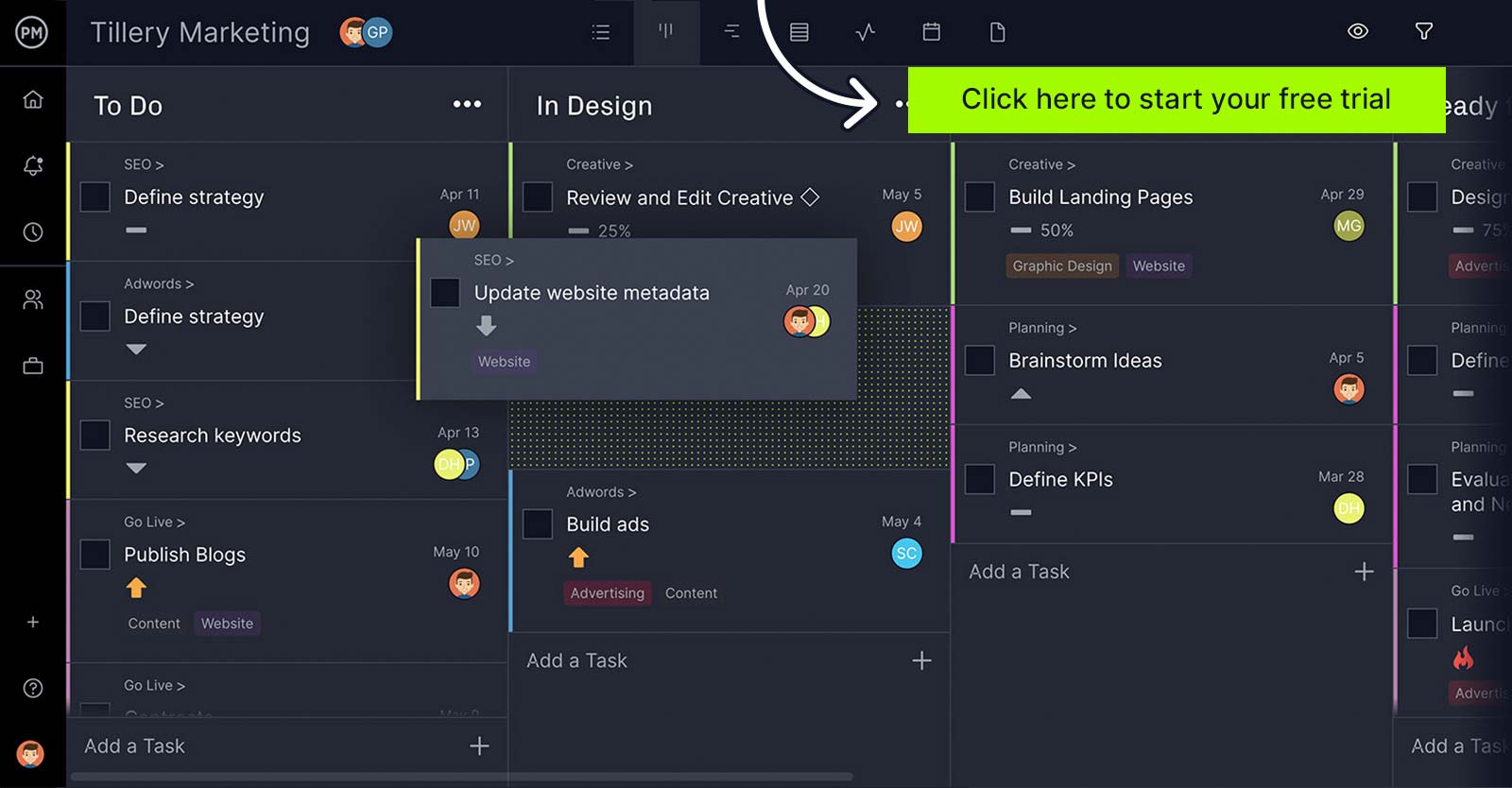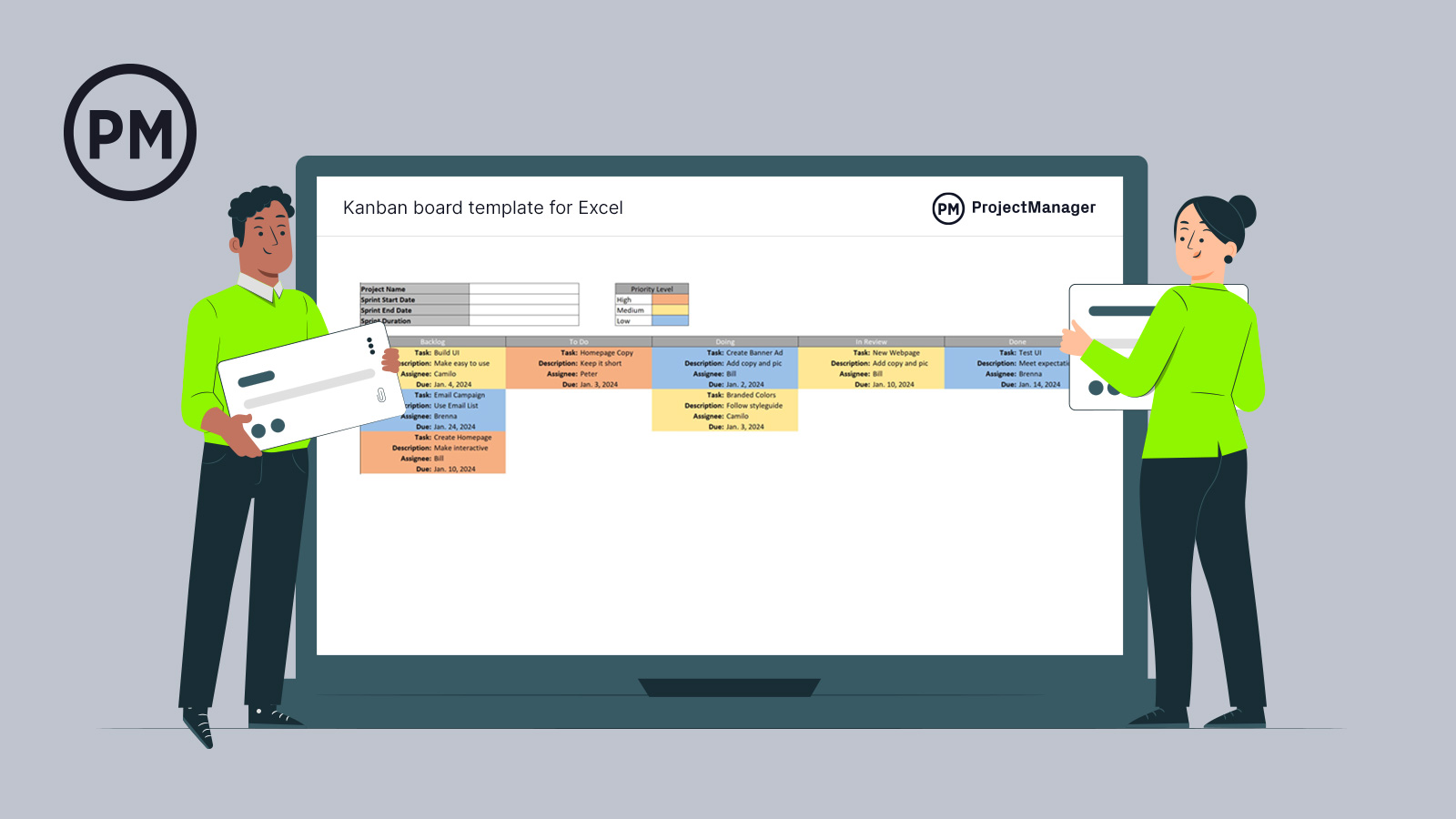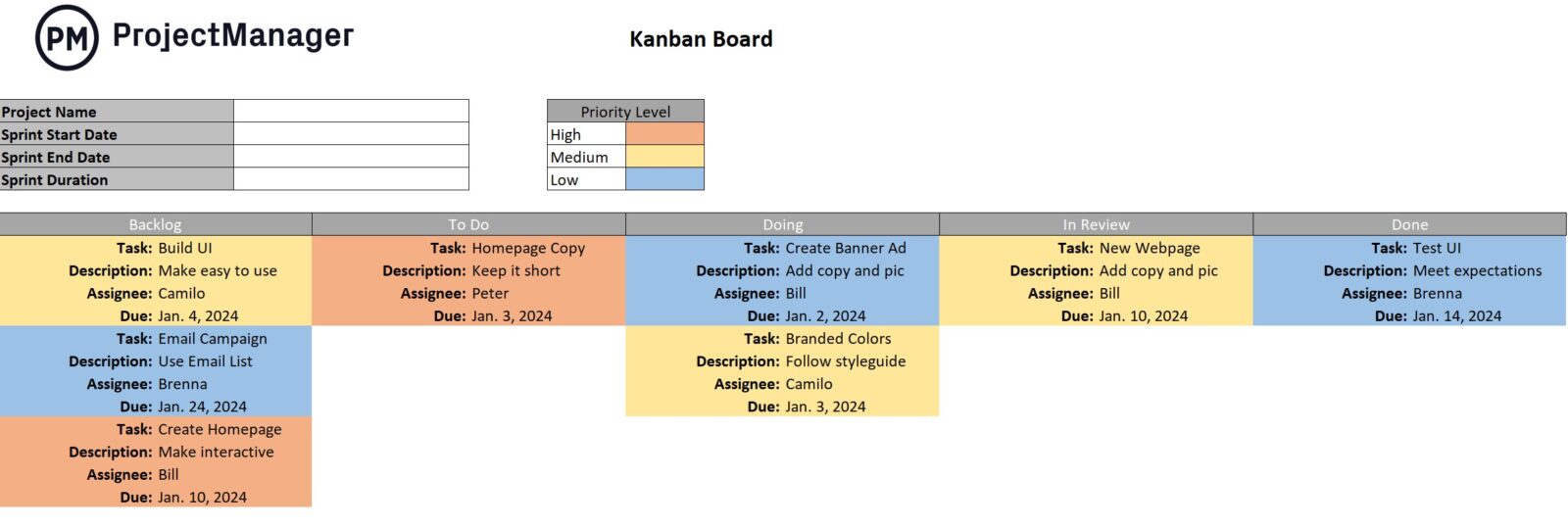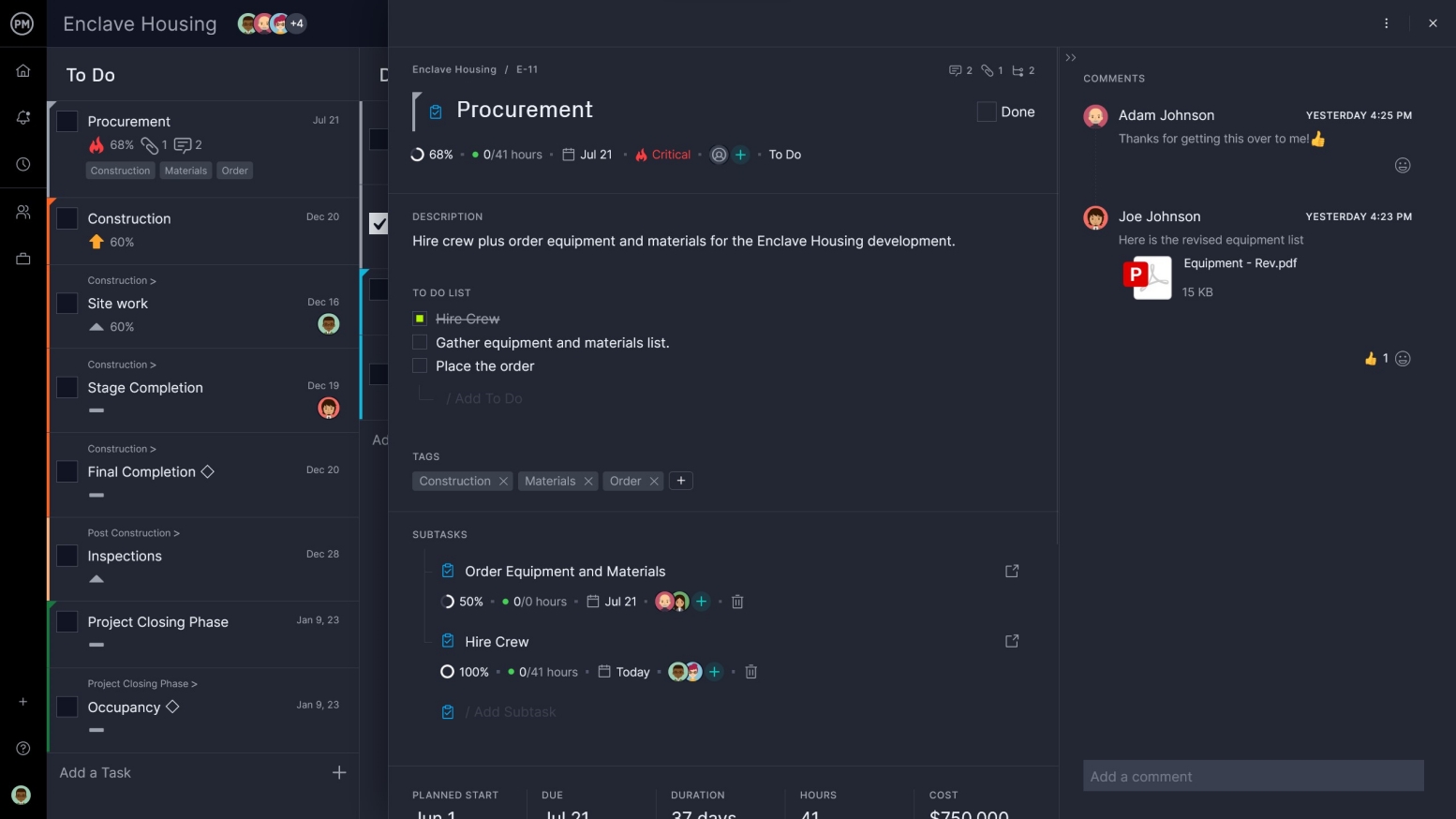Kanban is a visual workflow tool that, while originally used as a Toyota scheduling system, is now associated within an agile methodology, especially in DevOps software development. It can also be used in traditional project management methodologies.
As its popularity has grown, kanban boards have found a use in industries looking for a way to have everyone on the team view the state of their work. This requires real-time communication and an understanding of kanban principles.
The 4 Kanban Principles
The kanban method is governed by a set of principles. This allows for better management of the process, which improves the flow of work. The kanban method is constantly changing, and you should always be looking to find ways to improve the process.
These gradual improvements are a foundational pillar of the kanban principles. The goal is to always improve an organization’s processes. The four kanban principles were developed to use kanban in such a way that you’re always maximizing the benefits to your business process.
Improvements to kanban include better flow, a reduction of cycle time, increasing value to the customer and developing products that increase predictability. Naturally, these are crucial objectives for any business that hopes to stay in business.
Before defining the four kanban principles, it’s important to note that work management software adds greater efficiency. ProjectManager is cloud-based software that fosters real-time communications, keeping hybrid teams connected, no matter where or how they work. Get started with ProjectManager now for free.

1. Visualize Workflow
Kanban was designed to visualize the workflow. Anyone looking to implement the kanban method will need to visualize their workflow. What that means is putting your workflow on a board. That board, as mentioned above, could be an actual board, or kanban software. Then, you need to detail the steps in your process or production that deliver the service or product.
This results in a kanban board that on one end of the spectrum is very simple (the to-do, doing and done we outlined earlier) or it can be very complex depending on your process. Once the process of your work is on the board, such as all their work items, you can begin to visualize the work your team is doing.
The board can also have what’s called “swimlanes,” which are horizontal lines that break up your kanban board into sections to visualize different work types in your workflow. This separates work that follows a similar process from the other activities on your board. It can also be used to manage more than one project on a single board or to manage an individual’s work.
2. Limit Work in Progress (WIP)
Work in progress (WIP) is a term that refers to the tasks that are being worked on at the time, whether by the team or a single team member. This is an important kanban principle, as it can help prevent work overloads and improve workflow.
Also referred to as a pull system, limiting the WIP makes it more likely that team members will complete what they’re currently working on rather than moving on to the next task. In other words, before a new kanban card can be moved over to the next column, the card you’re currently working on has to be marked as done.
What this does is create capacity in the system. New work can now be pulled by the team. It might take some time before you can figure out what the WIP limit is, and it’s not unusual to start off without even having a limit to your work in progress.
The goal of lean kanban is to start with no limits and monitor the WIP. Once you have some experience and data, you’ll be able to make a more insightful decision as to how much to limit your WIP for each column on your kanban board. Whatever you decide on, adding the number to the column is a great way to communicate the limited capacity to the team and stakeholders.

Get your free
Kanban Board Template
Use this free Kanban Board Template for Excel to manage your projects better.
3. Focus on Flow
The kanban process is about visualizing workflow and in so doing managing it to improve that flow. Therefore, focusing on the flow of your board is a guiding kanban principle. These principles are in order, therefore, once you do the above two kanban principles, you can begin to manage the flow.
This is done by highlighting the different stages of the workflow and the status of the work in each of these columns. You’ll either see smooth sailing ahead or bottlenecks with work piling up, which impacts your capacity. This, of course, depends on how well you’ve defined the workflow and what WIP limits you have set.
What you’re looking for in a larger sense is how fast your work moves from the start to the finish of your workflow. This can also be called your value stream. Because of the visual nature of the kanban board, there is transparency that allows for the team to analyze the system and make adjustments as needed to improve flow and reduce the time it takes to complete tasks.
One way to do this is by looking at the intermediate wait stages or intermediate done stages and seeing how long tasks remain in these handoff stages. By reducing the time in a handoff stage you can reduce the overall cycle time. Improving flow leads to your team working more smoothly and predictably. Better forecasting means more accurate commitments to customers.
4. Continuous Improvement
Since kanban is evolutionary, which means change, you will be always reviewing and modifying your kanban process to improve the flow. This can be done by experimenting with small changes and making incremental improvements that can be easily handled by the whole team using the scientific management method.
This change management of improving collaboratively and evolving experimentally by using the scientific method you can form a hypothesis, test it and make informed decisions based on that method. The scientific approach of incremental change is the basis of lean and agile principles.
Therefore, a product owner should always be evaluating the process with the aim of achieving a continuous improvement to workflow. Each change is monitored and measured to make sure it’s doing what you want and not having the opposite effect.
You can collect kanban system data on your team’s service delivery manually on a physical board or automatically when using kanban software. The digital tools often have dashboards and reporting that monitor and detail these metrics to assist when evaluating performance.
Kanban Board Template
Our kanban board template is the perfect tool to get started with the kanban methodology. Simply add your project tasks, assignees, priority level and then move the kanban cards across the kanban board columns as your team members finish their tasks.

Kanban Best Practices
It’s clear that kanban boards are a powerful tool to foster collaboration, provide transparency and keep teams working at capacity while slowly improving workflow and accuracy when predicting delivery to your stakeholders or customers. While following the four kanban principles is required, there are other things you can do to get the most out of the kanban project management.
- Pull System: As mentioned, a pull system is when no new work is started until the tasks being worked on are complete. This is an essential practice in lean manufacturing and serves kanban well by keeping teams working at capacity. It controls the flow of resources in a system so they’re pulled into the pipeline only when needed. The pull system fulfills the goal of the kanban of supporting continuous flow and improving your lead time.
- WIP Limits: Having work-in-progress limits is a best practice that comes from agile development. As we’ve discussed in the kanban principles, this is a way to limit the maximum number of tasks that can be worked on in a column of the kanban board. By limiting WIP you’ll find it’s easier to see when there’s an inefficiency in your workflow. Because of the layout of the kanban board and the use of WIP limits, a product manager can catch bottlenecks before they impact the team and reallocate resources to keep the flow moving uninterrupted. But it also helps to meet daily with the team to get a feedback loop going.
- Flow Concept: Flow is one of the principles of lean thinking and means the way work moves through a system. The flow concept is that you want a good flow or a system where the work is going through the system in a steady and predictable manner. Bad flow is a system where work stops and starts over and over again. Keeping the flow constant means faster and more reliable delivery. That’s more value to your customer, team and organization.
Related: Best Kanban Software
Use ProjectManager’s Kanban Boards
ProjectManager is a work management software designed for hybrid teams. Our tool is cloud-based meaning that product owners are getting real-time data to analyze workflow and teams are able to collaborate no matter where they work, how they work or why they work.
Collaborate with Your Team
ProjectManager is collaborative to the core, which means that everyone on the team is connected and able to share documents or comment on their tasks with other team members in real time. Tag anyone on the project team and bring them into the conversation. Email notifications and in-app alerts make sure everyone is always up-to-date.

Multiple Project Views
But not everyone works the same way. Your agile teams will love the kanban boards but other departments in your organization might have more traditional ways to manage their work. That’s why we have multiple project views. If your leadership team is managing with a waterfall methodology they can use our interactive Gantt charts or sheet view, which is just like the Gantt only without the visual timeline. There’s also a dynamic task list and even a calendar that does much more than save important dates.

Track Progress in Real-Time
Monitoring your workflow is how you get continuous improvement. Our software tracks metrics in real time with our live dashboard. Unlike some software that makes you configure the dashboard, ours is ready when you are and automatically calculates the real-time data and displays it in easy-to-read graphs and charts to help achieve continuous delivery.

There are also one-click reports that can be filtered to show only the information you want to see. Then share it with stakeholders to keep them updated. Resource planning features help balance workflow and task management tools keep everyone working productively, whether on kanban boards or one of our other project views. Our software is the one solution for however you work.
Kanban Methodology Resources
If you’re looking for a deeper dive into kanban and how kanban software can help your system run smoothly and with greater predictability, then check out these kanban methodology resources.
- Kanban Methodology Guide: Our ultimate guide to kanban methodology covers a lot of what we discussed above and goes further into lean manufacturing, agile software development and scrum.
- Kanban Software Tools: For more information on ProjectManager, specifically everything you can do with our kanban boards, check out our kanban board software page to learn how to better organize, create workflows and collaborate.
- Kanban Inventory Management Guide: For details on how to run a kanban system, check out our blog post on kanban inventory management. It addresses challenges, offers guidelines and benefits.
- A Quick Guide to Kanban Cards: Kanban cards are the main element of kanban methodology. They describe the task, show who’s assigned, set priority and more, which you can learn about in this quick guide.
ProjectManager is award-winning work management and project management software that connects hybrid teams for greater productivity. Join the 35,000-plus professionals who are already delivering success at organizations as varied as NASA, Siemens and Nestles. Get started for free today!

